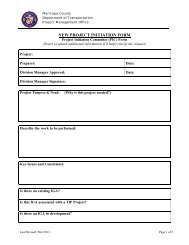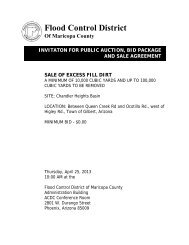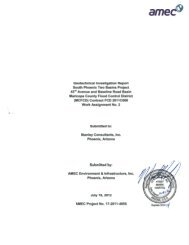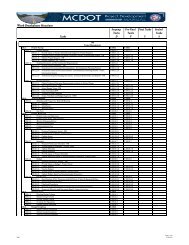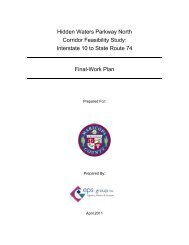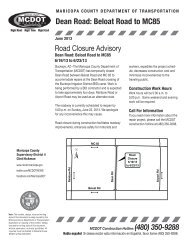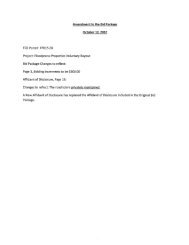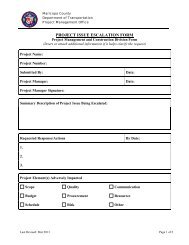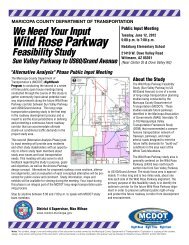Tech Memo #7 - Maricopa County Department of Transportation
Tech Memo #7 - Maricopa County Department of Transportation
Tech Memo #7 - Maricopa County Department of Transportation
You also want an ePaper? Increase the reach of your titles
YUMPU automatically turns print PDFs into web optimized ePapers that Google loves.
<strong>Tech</strong>nical <strong>Memo</strong>randum <strong>#7</strong>Traffic AnalysisPeoria Avenue Corridor Improvement StudyJackrabbit Trail Parkway to Dysart RoadA majority <strong>of</strong> the area adjacent to Peoria Avenue has a 2030 population density (less than 4persons per acre) which is lower than the current population density in the more urban areas <strong>of</strong>the valley (6 to 9 persons per acre). Therefore, it is likely that the 2030 socioeconomic dataused in the MAG model is well below the future potential “build-out” <strong>of</strong> the study area. Additionaldevelopment could occur beyond that reflected in the MAG 2030 socioeconomic data that wouldresult in increased travel demand along the Peoria Avenue corridor.Travel Demand Growth TrendsBased on the existing traffic volumes and the 2031 traffic projections, the travel demand alongPeoria Avenue is expected to experience substantial growth over the next 20 years. The annualgrowth rates vary from approximately 5 percent to 100 percent per year. While this type <strong>of</strong>growth in travel demand can occur as development occurs in undeveloped areas, these growthrates cannot be sustained over a long period. Assuming that the annual growth rate beyond2031 will be approximately 15 percent per year, the daily traffic volumes along a majority <strong>of</strong>Peoria Avenue will exceed 35,000 vpd by the year 2040.I-10/Hassayampa Valley <strong>Transportation</strong> Framework StudyAn expanded and updated version <strong>of</strong> the MAG regional transportation model was used t<strong>of</strong>orecast the growth in total travel demand and future changes in travel patterns in theHassayampa Study Area.As the first step in the update <strong>of</strong> the model, MAG developed new build-out population andemployment estimates. “Build-out” refers not to a specific future year, but rather to anunspecified date when urban development will have reached its highest level or maximumextent. These assumptions were based on an amalgamation <strong>of</strong> (1) expected land developmentpatterns and densities in general plans and comprehensive plans, (2) approved privatedevelopment plans, and (3) planned or proposed development plans. Each <strong>of</strong> these sourcesprovided a glimpse <strong>of</strong> the level <strong>of</strong> future development in the MAG planning area and,specifically, the density <strong>of</strong> development for all major land uses. Build-out represents the bestcurrent understanding <strong>of</strong> how the region will develop in the long term. Build-out <strong>of</strong> theHassayampa Valley is expected to occur at least 40 to 60 years in the future.Daily traffic projections were obtained from MAG for the Hassayampa Framework Study model.The daily traffic projections for Peoria Avenue from this model ranged from approximately30,000 to 60,000 vpd which would warrant a 6-lane arterial roadway.Conclusions<strong>Maricopa</strong> <strong>County</strong>, City <strong>of</strong> Surprise, and City <strong>of</strong> Glendale all classify Peoria Avenue as a 6-lanearterial facility. It is likely that the 2030 socioeconomic data used in the MAG model is wellbelow the future potential build-out <strong>of</strong> the study area. Additional development could occurbeyond that reflected in the MAG 2030 socioeconomic data that would result in increased traveldemand along Peoria Avenue. The MAG Hassayampa Framework Study travel demand modelwas based on a build-out scenario <strong>of</strong> western <strong>Maricopa</strong> <strong>County</strong> and produced daily trafficprojections that would warrant a 6-lane arterial facility. Based on the growth trends between2010 and 2031, a 6-lane facility may be warranted by approximately 2040.Page 28 January 2011





